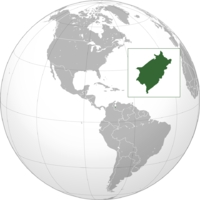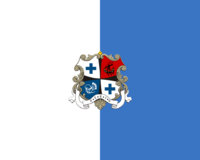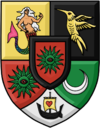Valtir Sector


The Valtir Sector (from the Middle Sabian valsê and tirénshin), also known as the Garrshirian Sector is a micronational sector in Western Venezuela, located in the heart of the Chama River Valley. Micronations originating from this sector are usually known as Garrshirians or Valtirians. From the foundation of the Republic of Cizland in March 2011 to the creation of the Juclandian overseas territory of Sabia and Verona in October 2012 the sector was characterized by severe instability and many cases of sockpuppetry headed by Tarik Kârjasary (formerly known in the micronational world as Richard Garrshire).
The Kingdom of Sabia and Verona, formed in 2012, is the most recent of the Garrshirian states, and has achieved relative stability. Since 2015, most of Sabia and Verona's activity has been based in Argentina, though it still lays claim to its Valtirian territories. Sabia and Verona is a member state of the Federal Union of Juclandian Lands, and was formerly an overseas territory of Juclandia.
Etymology
The term Garrshirian was coined in early 2012 taking the name of Richard Garrshire, pseudonym of Tarik Kârjasary during the Austenasian rule of the sector through the commonwealth of New Balland. The word was initially given to the series of micronations created by Kârjasary, which were usually characterized by their short existence and high political instability, but it was gradually applied to the sector in which these micronations tended to claim territory, the Chama River Valley in Western Venezuela, Kârjasary's homeland.
Since late 2014 the term Valtir has been applied to the sector as well. The word itself is of Sabian origin, a portmanteau of the words valsê (a name for the Ipomoea indica morning glory which commonly flowers in Northwestern Elinore) and tirénshin, a Sabian term for the central part of a valley, specifically and naturally the central part of the Chama River Valley. The name gained popularity over Garrshirian since Kârjasary stopped using the pseudonym in 2013.
History
Throughout its history ever since the creation of the Republic of Cizland in early 2011 the Valtir Sector has witnessed the creation of over twenty micronations and the administration of six foreign micronational powers (Juclandia, Würdigeland, Austenasia, Koss, Zealandia and Nemkhavia). The history of the sector is characterized by the raging instability that affected its early years. It wasn't until late 2012 that these changes stopped and stability reached the region.

2011
The first micronation in the sector was the Cizlandeese Republic (República Cizlandesa in Spanish), founded by Tarik Kârjasary on 16 March 2011. Shortly after the creation of the Republic, the Cizlandeese Empire (Imperio cizlandés) was created to replace the Republic. Both micronations, in a similar fashion to their early successors contained elements of fiction. The immediate successor to the Cizlandeese Empire was the Holy Dussesh Empire, a Holy Roman Empire-like micronation declared in April 2011 which took the fantasy elements to the next level by naming the fictional persona of Michelle Puente as the nation's Empress regnant. The Holy Dussesh Empire had a short life and following a fictitious military conflict the Kingdom of Montblanc was created in May 2011. Montblanc was the first of the sector's micronations to be nominally and officially headed by Kârjasary, who ruled as King of Montblanc and then as Protector of Montblanc until the foundation of the Berinese Confederation on 6 June 2011.

The Berinese Confederation was the first non-fictitious micronation of the sector. An imperial constitutional monarchy headed by Kârjasary as Emperor of the Berinese, the Confederation had an active population of 10 citizens and one overseas ambassador. During this period an early form of Pagan Pahunism was created. In August 2011 the Republic of Berin was declared and the Imperial monarchy was successfully abolished. The Republic however was still commanded by Kârjasary. During this period spanning from March to August 2011 the micronations of the sector had decreased the size of their territorial claims, from the entire old Gran Colombia in the Holy Dussesh Empire to several Venezuelan states in Montblanc, to a single state in the Berinese Confederation to a small portion of land in what is now the Valtir Sector in the Republic of Berin.
In September 2011 the Republic of Berin became a semi-autonomous republic of the Nemkhav Federation, marking the beginning of the foreign administration over the sector. The Nemkhav Republic of Berin was the first Valtirian state to adopt an actual Constitution as opposed to the vague and ambiguous civil codes employed by former micronations of the sector. Nemkhav Berin however suffered the same fate as its Valtirian predecessors and in November 2011 it was dissolved in order to establish Faryar, another foreign-administrated micronation (this time by Zealandia) with a Nordic thematic. The Faryar, a member of the now-defunct Zealandian Rekswhaleskabet was a devolved monarchy, with Queen Astrid of Zealandia as devolved ruler of the nation. Thanks to a period of inactivity The Faryar managed to last a couple of months longer than its ill-fated forefathers.
2012

The Valtir Sector welcomed 2012 under the rule of The Faryar. The Zealandian overseas territory came to an end in February 2012 when approaching the 1st anniversary of the Cizlandeese Republic's foundation the Principality of Montriac was founded, once again reminding the Micronational world of the sector's impecable instability. The Principality of Montriac was headed by Prince Claudio, an uncle of Kârjasary, who still served as head of government as Prime Minister. The Principality of Montriac was dissolved in March 2012 when after talks between Kârjasary and Lucas Campos of Koss (who had met Kârjasary while they were subjects of the Nemkhav Federation) the Kossian Empire was created. Under the Kossian Imperial Crown of Emperor Lucas I, Montriac became the Archduchy of Montriac, in a similar fashion to the Austro-Hungarian Empire. Koss became the third foreign power to invest in the Valtir Sector. Shortly after the declaration of joint rule of the Kossian Empire however tensions arose in a dispute over a treaty enacted in Arceu. Said disagreement, in addition to the Grand Unified Micronational denying the Archduchy full membership to the organisation due to its position under the Kossian crown led to the creation of the rebel Republic of Montriac, headed jointly by Kârjasary and Isadora Annenak. On 12 March 2012 the so-called Kossian Civil War was started, only to end five days later on 17 March leaving no casualties but the prides of all those involved.

To the surprise of no one, the Republic of Montriac never made it too far, and on 16 March 2011 it was dissolved to be succeded by the Republic of Czea, which didn't last more than a week either, and on 24 March 2012 the Democratic People's Republic of Czea was declared. The Democratic People's Republic of Czea or DPRC was (as its name blatantly indicates) a socialist state under the influence and advice of Tianan leader Joseph "Puggy" Puglisi. Unaware to most of the micronational community and to Puglisi himself, the DPRC was also heavily fictional and emulating its early 2011 ancestors, the DPRC was de jure headed by Emiliana Torroja, yet another fictitious persona created by Kârjasary. However, the socialist thematic didn't stick to the secto, and on 1 April 2011 the Federal Union of Cizland was created. This time, one fantasy leader wasn't enough, and so Cizland boastged a Federal Council of non-existent heads of state to rule over an army of non-existent mayors, legislators, and citizens who lived in the imagination of Kârjasary for about two weeks until the dark shadow of boredom posed itself over the sector once more, and Cizland was dissolved. Now, the name of Berin was revided through the Berinese Empire.
The Berinese Empire, alternatively known as Empire of the Great Berin and Second Berinese Empire, had an innovative LaVeyan Satanist thematic, and it is mostly remembered as the place of origin of the Order of the Baphomet, which stands to this day. Kârjasary ruled as Emperor of Berin until 20 April 2012 when the Empire discarded its Declaration of Independence and became the commonwealth of New Balland, a protectorate of the Empire of Austenasia a la Saint Lucia. Thus, Austenasia became the fourth foreign ruler of the Sector. By May, New Balland had stopped being a novelty, and Kârjasary recurred to the skeleton of Pahunism to create the Church of the Pahun, and via the Church, the State of Dakrit was created. As it was expected, the State of Dakrit didn't make it and having run out of political theories to adopt to his states, Kârjasary decided to create a simple, unitary republic that would be known as the Union of Artaghe.
Founded in June, the Union of Artaghe would also be known as the first of the Valtir's two Golden Ages. With a steady government and the help of Aina Oehler, Runa-Lisandra Bartolucci and former Kozuc Liam Barnard it appeared as if stability had finally reached the Chama River Valley in the form of a blue-red-white coloured eagle. But the MicroWiki Community had been bamboozled, for in August 2012 Kârjasary dissolved the Union and the Principality of Artaghe was established. The Principality, a city-state with Satanist tendencies reminiscent of the Second Berinese Empire, fell into inactivity by September, and in October it met its inevitable fate.
Sabia and Verona and the Second Golden Era

Towards the end of September and the beginning of October plans to establish a Würtige colony in the Valtir were drawn. It came to be Listva, and it existed as a weak state for a while before falling into oblivion like so many micronations before it had before. When it seemed that the entire sector was cursed and all micronations claiming territory in the Chama River Valley were doomed to fall apart, an agreement was forged between King Ciprian of Juclandia and Kârjasary. The Juclandian Overseas Territory of Sabia and Verona was founded on 20 October 2012.
Where other past Garrshirian micronations had failed, Sabia and Verona succeeded and excelled. The nation quickly grew and through several elections, the creation of new conlangs and the reclamation of a relatively small and easy to control territory, Sabia and Verona surpassed all expectations when in March 2013 it became the oldest micronation of the sector at its five months of existence, and in October 2013 it cemented its position as the Valtir's micronational Messiah by turning one year old against all odds. The creation of the Realm of Lycem in December 2012 and its subsequent annexation into Sabia and Verona in February 2014 strengthened the region's cultural and social prowess. In 2014 Sabia and Verona gained further autonomy with the creation of the Federal Union of Juclandian Lands and the coronation of Queen Isadora of Annenak, who worked as Vicereine of Faryar and President of the rebel Republic of Montblanc, which marked the beginning of the Isadoran Era.
Geography


The exact territory the Valtir spans is subject of debate. Due to the fact most Garrshirian micronations have had different territorial claims it's hard to calculate precisely the exact size of the Valtir Region. In modern times it's commonly accepted that the Valtir is comprised by the lands south of the Umo River, north and west of the Hidram River and east of the Road of Odargoná. This would place the Valtir Region in a square of land Southwest of the Parra Parish of the Libertador Municipality. However historically the sector has occupied much more land, ranging from the entire West of Venezuela to all of Venezuela, Colombia and Ecuador.
Languages
The Valtir Sector is located in Venezuela, a country where Spanish is the predominant language. Thus, Spanish has always been an important factor of all Valtirian micronations ever since the Cizlandeese Republic to the present day. However many conlangs have been devised through the passage of time and the sector counts with a variety of active and deceased micronational languages.
Conlangs have been seen in the sector as early as April 2011. The Dussmarchoise language of the Holy Dussesh Empire is an early example of conlanging in the region. The language was intended to be of the Slavic family, most likely based on the Russian language. The Old Berinese language of the Berinese Confederation had Uralic influences and Finnish-like phonaesthetics. The Berinese language of the Republic of Berin however was an Ibero-Romance language, as was the Montblancqi language of Montblanc. The Faryaese Zealandian dialect and the Artaghean language were both based on Icelandic and had strong Nordic influences, as well as Spanish intertwinned in their lexicons. Dakrit employed a modification of the Aytanaic Pahdur language (which was derived from the Old Berinese language) now known as Dakritic Pahdur, which was the base of the Pahdur langauge used as liturgical language of the Church of the Pahun nowadays. During the short existence of Listva and the early stages of creation of Sabia and Verona the Listvatean language (sometimes mistakenly called Sabioveronese language) had its roots in the Catalan language.
The creation of Sabia and Verona represented a new age for the introduction of conlangs to the Valtir sector. Currently three conlangs are under development in Sabia and Verona, the Sabian language, the Pashqar language and the Lycene language. The Lycene language surged as a dialect of the Sabian language, intended to be used in the once-independent Lycem. It is now the official language of the Region of Lycem and the Elinore Prefecture. The Pashqar language was created to be used in the Region of Verona (also known as Pashqaria), while the Sabian language, originally created to be used only in the region of Sabia has grown to be the most used conlang in Sabia and Verona, and it's commonly used as the Kingdom's lingua franca.
Several existing languages have also been attempted to be introduced in the Valtir, such as German in the Holy Dussesh Empire, Basque in Nemkhav Berin and Korean in Napoléon Bleuberrie's early Sabia and Verona. English was the official language of New Balland, although the English language has always been used one way or another in the sector, mostly to communicate with the outside world.
